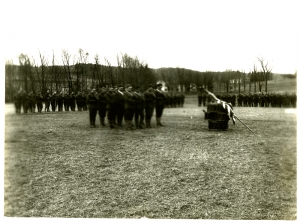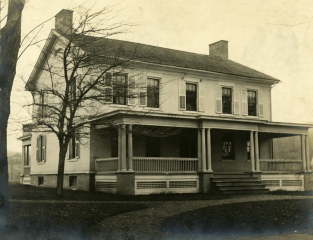Centennial celebration. Over 1,200 alumni returned for the festivities held October 9-12. Since the University was in session the problems of feeding and housing were of major proportions but accommodations were found in the village and cots set up in campus buildings and large tents erected near the Administration Building for serving meals. The program included: Dean Crawshaw’s Centennial Ode, Dr. Lawrence’s Historical Address, Harry Emerson Fosdick’s tribute to the memory of the Gold Star servicemen, an alumni dinner, an academic convocation addressed by the New York State Commissioner of Education, John H. Finley; a football game with Brown University which Colgate won; and a concluding chapel service.
The most epoch-making feature of the Centennial was the founding of the Colgate University Alumni Corporation to supersede the old Alumni Association. It was designed as an efficient, permanently-staffed organization to keep in close touch with the graduates and to give them an opportunity to take a mote active part in University affairs. Twelve directors were immediately elected and they later chose George W. Cobb, ’94, who had been one of the corporation’s chief builders, President; Raymond E. Brooks, ’06, Vice-president; Professor Alfred E. Alton, B.D., ’02, Secretary; and Professor Harold O. Whitnall, ’00, Treasurer. Soon the corporation had an office on campus with Professor Alton in charge. Within a brief period he perfected class organization among the alumni; established and edited the Colgate Alumni Maroon (Colgate Alumni News) which replaced the sporadic Alumni Quarterly; opened a large correspondence with alumni; and helped to collect over $19,000 in support of the organization and the University. Encouraged by the success of the first few months the Directors in 1920 took the lead in launching the campaign for $1,000,000 and a new gym, in which Dr. Alton played a large role.
Before the campaign had concluded Dr. Bryan resigned effective June 30, 1921, to become President of Ohio University at Athens. He had led Colgate in one of its most notable periods 6f expansion-in size, buildings, faculty, and resources. His wisdom, genial friendship and personal interest won him lasting appreciation.
Responsibility for carrying on the affairs of the University fell on Vice President Read, now made President pro tem. The confusion of the post-war years added to his burdens which he shouldered with distinction. He drew together “the threads of cooperation” and kept up the general morale in a difficult transition period.






